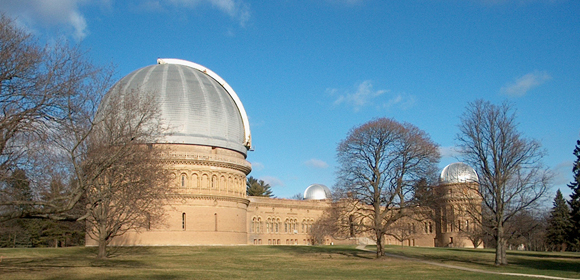| Sun | Mon | Tue | Wed | Thu | Fri | Sat |
|---|---|---|---|---|---|---|
| 1 | 2 | 3 | 4 | 5 | ||
| 6 | 7 | 8 | 9 | 10 | 11 | 12 |
| 13 | 14 | 15 | 16 | 17 | 18 | 19 |
| 20 | 21 | 22 | 23 | 24 | 25 | 26 |
| 27 | 28 | 29 | 30 | 31 |
CATEGORIES
RECENT ENTRIES
BLOG ROLL
Keep watching the skies

Yerkes Observatory has a special place in my heart. It was there—the University’s beautiful, historic, and underused observatory in Williams Bay, Wis.—that I decamped after graduating from the College, intent on hunting killer asteroids. I spent the better part of a year living and working in the building, battling a balky telescope and Wisconsin’s none-too-mild winter. I made little progress—and no money; I volunteered my labor—but, as an engineer pointed out to me one day over lunch, it sure beat sleeping on my parents’ couch.
In terms of science, the observatory and its famous 40-inch refracting telescope became outclassed years ago. The University has been trying to figure out what to do with the facility for years. (I won’t rehash the debate here; just go read this and this.) Since I’m fond of the old place, it always makes me happy to see someone putting the observatory equipment to good use—such as when I learned that my old telescope was being prepared to join Skynet, a network of robotically operated telescopes located all over the world.
To learn more, I called up Vivian Hoette, the observatory’s educational outreach coordinator and point person for Skynet, whom I had known from my days in Williams Bay. Skynet, she explains, was founded in 2006 by an astronomer at the University of North Carolina, U of C alum Dan Reichart, SM’98, PhD’00; Hoette was part of the education plan for the original grant proposal. The Skynet software controls telescopes remotely, as well as prioritizes observations and processes images online. Soon, it will link more than 20 telescopes on four continents, including two of the smaller telescopes at Yerkes.
The 41-inch and 24-inch reflectors are in fine operating condition, but are too small for the kind of research that goes on at the University today and so are underutilized. Adding them to Skynet increases their scientific utility considerably. The 24-inch already uses Skynet's image processing functions, but can't be remotely controlled. Meanwhile, my old 41-inch will have its telescope control system integrated with Skynet and the controls for its protective dome automated.
Skynet was designed to research gamma-ray bursts, flashes of high-energy photons from the distant universe that often last less than a second. But the ability to control a telescope remotely also made it perfect for educational outreach—which is where Hoette steps in. Now, she uses Skynet telescopes to show students in Wisconsin how astronomy is done even when the local sky is covered with clouds.
The University’s internal debate about what to do with Yerkes doesn’t have an easy resolution. (If it was easy, it would have been resolved by now.) But as an admittedly sentimental fan, it’s good to see this old dog can still learn new tricks.
Benjamin Recchie, AB'03
April 30, 2010
